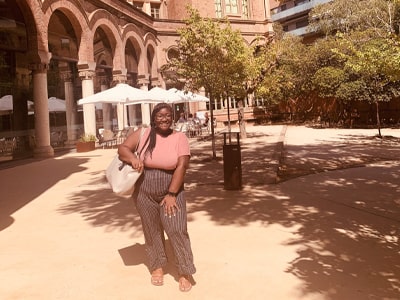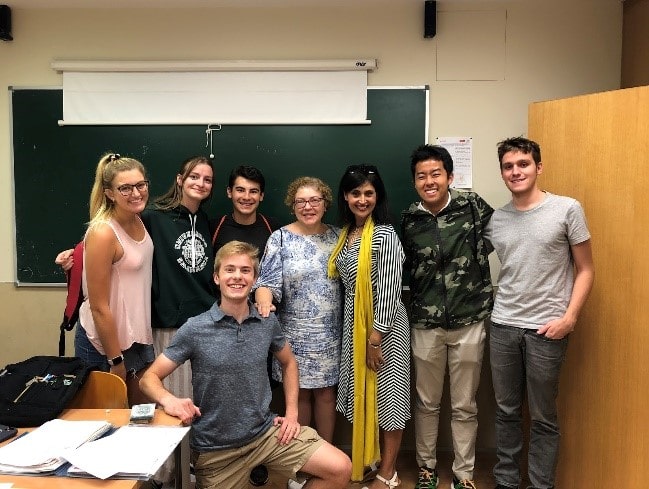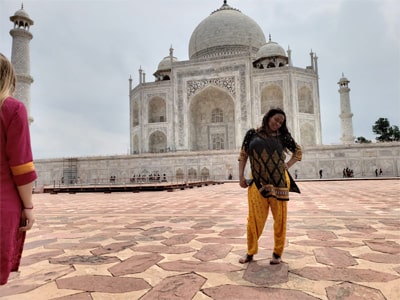Europe
- Belgium
- Czech Rep.
- England
- France
- Germany
- Greece
- Ireland
- Italy
- Netherlands
- Portugal
- Scotland
- Spain
- Switzerland
Belgium
Indigenous Communities: For centuries before gaining independence from the Netherlands and forming the modern state of Belgium in 1830, many European cultures, including Romanized Celts and Gothic Germans, inhabited the land. Today, the Fleming in the north and the Walloon in the south are two of the most prominent cultural groups, with the Fleming still working to gain equal status and political influence as the Walloons.
Languages: French, Flemish, and German are the three official languages of Belgium, with French and Flemish being the most widely spoken.
Race & Ethnicity: Belgium is predominantly white. Given Belgium’s colonial history and involvement in the transatlantic slave trade, its language and culture are shared globally. This makes Belgium attractive for immigrants, which has helped increase the country’s racial and cultural diversity, especially in the larger cities.
Religion: Most Belgians identify as Roman Catholics while Protestantism, Islam, Judaism, Anglicanism, Islam, Greek and Russian Orthodox Christianity, and secular humanism are all officially recognized as well. Buddhism and Hinduism are not officially recognized, despite requests.
LGBTQIA+: Belgium is widely considered a safe place for members of the LGBTQIA+ community. There is a lot of social acceptance as well as progressive legislation.
Disabilities Access: Belgium is a relatively accessible location for people with varying level of physical ability. Though there can still be some challenges accessing older buildings and neighborhoods, many restaurants and much of the public transportation system is accessible.
⇑ Back to top
Czech Republic
Indigenous Communities: The dominant cultural group in the Czech Republic are the Czechs, who make up roughly 67% of the population. Before the fall of the Soviet Union, the Czech Republic and Slovakia were one nation and there are still Slavic communities as well as those of the Moravian and Romani people.
Languages: Czech is the official language but many also speak Romani, German, or Polish.
Race & Ethnicity: The Czech Republic is comprised predominately of white Europeans. There is much more racial and ethnic diversity in Prague than in the rest of the country.
Religion: The Czech Republic is one of the most secular nations in the world, partially due to the religious restriction of the former communist rule. Czech people are generally tolerant of religion though most believe worship to be a private matter. Following the secular majority, the remainder of Czechs tend to be Roman Catholic, Protestant, Muslim, or Jewish.
LGBTQIA+: The Czech Republic is considered progressive in Central Europe with respect to LGBTQIA+ rights. Though relatively queer-friendly, there is still a long way to go with some of the Czech Republic's transgender-related legislation.
Disabilities Access: The Czech Republic has largely modern infrastructure that is accommodating to people with varying levels of physical ability, though older neighborhoods and buildings may not be as accessible as more modern parts of the country.
⇑ Back to top
England
Indigenous Communities: The Celtic Britons were a prominent indigenous tribe who inhabited England before the 1st century. Their culture and language were dispersed over time into distinct groups as the Anglo-Saxons and others settled in the territory.
Languages: English is the official language, though there are many unofficial languages spoken throughout the country.
Race & Ethnicity: The English population is largely white, though its cities are home to a mix of races, ethnicities, and cultures. The country’s language and culture spread widely during colonial involvement abroad and in the transatlantic slave trade. This created linguistic and cultural ties across the globe, leading to increased immigration and diversity.
Religion: Though most of England is secular, Christianity is the most widely practiced religion, followed by Islam. The predominant belief is that religion is a personal matter, and it is rarely discussed publicly.
LGBTQIA+: England is considered very safe for LGBTQIA+ individuals. Though there is a lot of progressive protections and legislation, a portion of the population maintains conservative traditional views and are intolerant of the queer community.
Disabilities Access: England is generally very accessible for people with any level of physical ability. Though spaces may be more difficult to navigate outside of larger cities, progressive legislation requires accessible public buildings and public transportation.
⇑ Back to top
France
Indigenous Communities: The Gauls were a prominent cultural group before the official formation of modern France, and the Basque people are believed to be the oldest inhabitants. Until the 15th century, France was the end of the known world and many migrants from the Middle East, Africa, Europe, Central Asia, and the Nordic lands had settled there.
Languages: French is spoken throughout the country, and French people take great pride in the language as it’s closely linked to the national identity. There are also many regional dialects that get little official recognition; some include Provencal, Breton, Alsatian, Corsican, Catalan, Basque, Flemish, Occitan, and Picard.
Race & Ethnicity: The largest racial group in France is white. France is also home to the largest Black population in Europe. The French language and culture were spread widely during French colonial involvement abroad. These linguistic and cultural ties have made it an attractive place for immigrants, which has fostered cultural diversity, especially in French cities.
Religion: Catholicism is the most prominent religion in France though faith is thought to be a private matter and kept mostly out of the public sphere. Judaism, Islam, and Buddhism are also common in France, and other religions can be practiced openly.
LGBTQIA+: France is progressive in their LGBTQIA+ legislation and is generally considered a safe place for members of the queer community.
Disabilities Access: France is a relatively accessible location for people with varying levels of physical ability. Though accessing older buildings or neighborhoods is not as easy, most restaurants, universities, and much of the public transportation system is accessible.
⇑ Back to top
Germany
Indigenous Communities: Many early agrarian communities, including the Celtics and Slavs, inhabited Germany.
Languages: German is the official language with three dialects spoken in distinct geographical regions, which are generally understood by all German speakers. Some other regionally popular languages include North Frisian, Romani, and Sorbian.
Race & Ethnicity: There is a growing population of international immigrants in Germany and the predominately white country largely embraces a multi-cultural identity. This multi-cultural emphasis is aimed to heal from the German Holocaust, which targeted Jewish individuals as well as the Romani and other groups. Germany is currently home to large communities of Turkish, Middle Eastern, and North African people.
Religion: Germany is quite secular, and religion is believed to be a private matter. About a third of the population identify as not religious while Protestantism, Catholicism, Islam, and Judaism are some of the prominent religions. Religious freedom is legally protected.
LGBTQIA+: Germany is one of the most progressive countries in the world for LGBTQIA+ rights. There are robust anti-discrimination laws and an active queer community.
Disabilities Access: Modern infrastructure and transportation systems make Germany very accessible for people with varying levels of physical ability. Though historic spaces or those outside of the cities may be more difficult to navigate, there is a lot of support available given the country’s progressive legislation.
⇑ Back to top
Greece
Indigenous Communities: The Minoans were the first Greek civilization on the island of Crete followed by the Mycenean on the mainland. Many migrations, invasions, and imperial conquests followed leading to a lot of cultural diversity in Greece.
Languages: Greek is the official language, though there are some regional dialects, like Cypriot and Pontian, also spoken.
Race & Ethnicity: The Greek population is predominately white with a mix of Mediterranean ethnicities, including North African lineages. The Muslim Thráki (Thrace) are its only other officially recognized group, though there are large numbers of Turks, Macedonians, Albanians, Bulgarians, Vlachs, and Roma. In recent years, Greece has seen an influx in migration from Africa and the Middle East.
Religion: There is religious freedom in Greece but the Greek Orthodox church, a Christian organization, is recognized as the official religion. Protestantism, Catholicism, Judaism, and Islam are also commonly practiced in Greece, though ani-Semitism and Islamophobia have grown in recent years.
LGBTQIA+: LGBTQIA+ individuals are generally socially accepted by the Greek public and many antidiscrimination laws exist. Especially outside of the cities in Greece, there is still a conservative religious culture that is less tolerant of the LGBTQIA+ community.
Disabilities Access: Certain areas of Greece's cities and islands have modern infrastructure and are more accessible for people with varying levels of ability. Older towns and more rural places are not as accessible, with uneven and narrow surfaces.
⇑ Back to top
Ireland
Indigenous Communities: The earliest people in Ireland were believed to have migrated from Scotland at the end of the last ice age. The Celtic Irish were later the most prominent group, with tribes all over Ireland.
Languages: Irish, or Gaelic, and English are both official languages. Today, English is the most used.
Race & Ethnicity: Without the colonial legacy of other European nations, Ireland has fewer non-Irish communities and is relatively homogenous, with white people as the largest racial group. Ireland is generally considered welcoming to immigrants, the majority of whom reside in the larger cities.
Religion: Though Ireland has no official religion, most people identify with Catholicism or Christianity. Before the spread of Christianity, many Celtic religions—polytheistic pagan wisdom traditions—were predominately practiced and many of those beliefs are intertwined with modern Christianity. Judaism and Islam are also commonly practiced.
LGBTQIA+: There are many antidiscrimination laws protecting LGBTQIA+ individuals in Ireland. The public is generally socially accepting, though there is also a conservative Catholic community that still view LGBTQIA+ engagements as sinful.
Disabilities Access: Ireland is a relatively accessible location for people with varying levels of physical ability. Accessing older buildings or neighborhoods is not as easy, but most restaurants, universities, and much of the public transportation system is accessible.
⇑ Back to top
Italy
Indigenous Communities: Many groups existed in Italy before the Roman expansion and conquest including the Italics, Celts, and ancient Greeks.
Languages: Italian is the officially recognized language though German, French, and Slovene are also regionally spoken.
Race & Ethnicity: Italy is predominately white with a mix of regional cultures and identities. The population is increasingly diverse, especially in larger cities, with growing communities from Asia, North Africa, the Middle East, and other European countries.
Religion: Italy is officially secular though the culture and communities are deeply influenced by the Roman Catholic church. Catholicism, though declining, is the most practiced religion, followed by Islam. A large percentage of the population also identify as atheist or agnostic.
LGBTQIA+: Members of the LGBTQIA+ community are generally accepted in Italy, although the prominence of Catholicism creates some social stigma. LGBTQIA+ communities and spaces are more common in larger cities than in rural areas.
Disabilities Access: Though there are laws requiring the accessibility of public transportation and public buildings, Italy's old-world layout and architecture makes some places less accessible for individuals with mobility limitations.
⇑ Back to top
Netherlands
Indigenous Communities: There are three native Germanic ethnic groups to have first lived in the Netherlands: the Saxons, the Franks, and the Frisians.
Languages: The official language of the Netherlands is Dutch. English is widely spoken, and German is common as well.
Race & Ethnicity: There is a growing population of international immigrants in the Netherlands, and the predominately white country embraces a multi-cultural identity. The Dutch language and culture spread widely during colonialization and participation in the transatlantic slave trade. This created linguistic and cultural ties across the globe, leading to increased immigration and cultural diversity.
Religion: Since the end of the 20th century, there has been a significant decline in religious practice and Christianity in the Netherlands. Most of the country does not identify with any religion, with about 30% identifying as Christian. There is also a growing Muslim community.
LGBTQIA+: The Netherlands is widely considered a safe place for members of the LGBTQIA+ community. There is a lot of social acceptance and progressive legislation.
Disabilities Access: The Netherlands is a relatively accessible location for people with varying levels of physical ability. Though there can still be some challenges accessing older buildings and neighborhoods, many restaurants and much of the public transportation system are accessible.
⇑ Back to top
Portugal
Indigenous Communities: Portugal has been home to many tribes and cultural groups dating back to the Celts, Romans, Moors, and Germanic tribes all of these influences making up the modern Portuguese nation.
Languages: Portuguese is the official language throughout the country. Mirandese is also an official language of Portugal, but is only sparsely spoken in northeastern Portugal.
Race & Ethnicity:Portuguese people make up 95% of the ethnic identity of Portugal. The remining 5% of the population includes citizens from Portugal’s former colonies in Africa and Brazil, as well as from Asia and the Americas.
Religion:Around 80% of the population in Protugal is Roman Catholic. The remaining population includes Protestants, other Christians, and non-religious people.
LGBTQIA+: Portugal is progressive in their LGBTQIA+ legislation and is considered a safe place for members of the community.
Disabilities Access: Some areas of Portugal are hilly with cobblestone streets and may be difficult to access for people with physical disabilities.
⇑ Back to top
Scotland
Indigenous Communities: The original Scots, after whom Scotland was named, were Gaelic-speakers from Ireland who settled in the western part of the country in the fifth century.
Languages: Scotland's most spoken language is English, with Scots and Scottish Gaelic also widely used.
Race & Ethnicity: The Scottish population is relatively racially homogenous, primarily comprised of white Europeans. There are some international communities, the most numerous being from Asia.
Religion: A large portion of the Scottish population identifies as non-religious. The next largest group identify with the Catholic Church of Scotland. There are also communities of Muslims, Buddhist, Hindus, and Sikhs. There are also many who integrate Celtic spiritual practices.
LGBTQIA+: Scotland has some of the most progressive LGTBQIA+ protections in Europe. Every single year since 2015, Scotland has ranked as one of the top four countries for LGBTQIA+ equality and human rights on ILGA-Europe’s ‘Rainbow Index’.
Disability Access: Most modern buildings and newer busses and trains are accessible to those with mobility limitations. However, older buildings are not as accessible. Many locations such as tourist attractions and banks are fitted with hearing loops, have audio guides, and/or braille guides.
⇑ Back to top
Spain
Indigenous Communities: Spain has always been home to many cultural groups including the Iberians, Catalans, Basques, Moors, and Celts. Spanish unification is marked as far back as the 15th century and there is still some social deliberation about the roles and expressions of these cultures in modern-day Spain.
Languages: The official national language of Spain is Spanish. Many other languages are officially recognized in different regions, including Basque, Catalan, Aranese, Galician, and Valencian.
Race & Ethnicity: The Spanish population is predominately white with a mix of regional cultures and identities. The Spanish language and culture were spread widely during colonial involvement and participation in the transatlantic slave trade. This created linguistic and cultural ties across the globe leading to increased immigration and cultural diversity. About 90% of the Spanish population identify as Spaniards with growing populations from many places including Romania, Morocco, and Ecuador.
Religion: The predominant religion is Catholic Christianity. While the majority of Spain identifies as Catholic, about half report being non-practicing. However, there is no official national religion, and the country upholds religious freedoms.
LGBTQIA+: Spain is progressive in their LGBTQIA+ legislation and is considered a safe place for members of the community.
Disabilities Access: Spain is a relatively accessible location for people with physical disabilities. Visiting older buildings or neighborhoods may not be as easy, but many restaurants, universities, and much of the public transportation system is accessible.
⇑ Back to top
Switzerland
Indigenous Communities: Originally, the country was inhabited by Celtic tribes in the west and south and by the Rhaetians in the east. With the collapse of Roman rule, Germanic tribes poured in, among them the Alemanni and Burgundians. The Alemanni ultimately became Switzerland’s dominant group.
Languages: There are four languages spoken in Switzerland: German, French, Italian, and Romash. German is the most widely spoken, predominately in North and East Switzerland. French is spoken in the western part of Switzerland, Italian in the south, and Romansh in the east’s Grisons province.
Race & Ethnicity: The Swiss are predominately white, though the population is becoming more racially and ethnically diverse. Modern Switzerland is often cited as a model for new efforts at creating unification due to its atypical political integration of a multiethnic and multilingual population.
Religion: Switzerland has considerable religious diversity, and many people can feel comfortable openly practicing their religions. Currently, Roman Catholics slightly outnumber Protestants, and there is a small but significant Muslim population, as well as a small Jewish community.
LGBTQIA+: Switzerland is tolerant and LGBTQIA+ friendly, especially in more urban areas. LGBTQIA+ rights in Switzerland are relatively progressive, although LGBTQIA+ people lack full legal equality.
Disabilities Access: Switzerland ranks among the world’s most easily navigable countries for travelers with physical disabilities. Most train stations have a mobile lift for boarding trains, city buses are equipped with ramps, and many hotels have wheelchair accessible rooms.
⇑ Back to top
Being Black in Barcelona
In the United States the last few years the black experience has been documented, filmed, produced over and over from every day life... Read more
Some Tips for Students of Minority Populations Studying Abroad in Spain
I had a great time abroad, and I am hoping to have the privilege to travel again really soon. That being said, as a... Read more
Important Questions to Ask Before Studying Abroad in Greece
I feel as if I floated here on dreams that I had as a poor child growing up in Fresno wanting more than just an ordinary life... Read more




